15-3 Astronomers use a variety of techniques to study asteroids
Many asteroids have been battered by collisions with other asteroids
Although the asteroid belt is mostly empty space, collisions between asteroids should occur from time to time. Asteroids move in orbits with a variety of different eccentricities and inclinations (see Figure 15-3), and some of these orbits intersect each other. A collision between asteroids must be an awe-inspiring event. Typical collision speeds are estimated to be from 1 to 5 km/s (3600 to 18,000 km/h, or 2000 to 11,000 mi/h), which is more than sufficient to shatter rock. Recent observations show that these titanic impacts play an important role in determining the nature of asteroids.
Observing Asteroids with Telescopes, Radar, and Spacecraft
 State-of-the-art optical telescopes barely have the resolution to reveal surface details on large asteroids such as Ceres, Pallas, and Vesta (Figure 15-5). These asteroids resemble miniature terrestrial planets. They have enough mass, and hence enough gravity, to pull themselves into roughly spherical shapes. These large asteroids are likely to have extensively cratered surfaces due to collisions with other asteroids in the asteroid belt.
State-of-the-art optical telescopes barely have the resolution to reveal surface details on large asteroids such as Ceres, Pallas, and Vesta (Figure 15-5). These asteroids resemble miniature terrestrial planets. They have enough mass, and hence enough gravity, to pull themselves into roughly spherical shapes. These large asteroids are likely to have extensively cratered surfaces due to collisions with other asteroids in the asteroid belt.
Optical telescopes reveal much less detail about the smaller asteroids. But by studying how the brightness of an asteroid changes as it rotates, astronomers can infer the asteroid’s shape. An elongated asteroid appears dimmest when its long axis points toward the Sun so that it presents less of its surface to reflect sunlight. By contrast, a rotating spherical asteroid will have a more constant brightness. Such observations show that most smaller asteroids are not spherical at all. Instead, they retain the odd shapes produced by previous collisions with other asteroids.
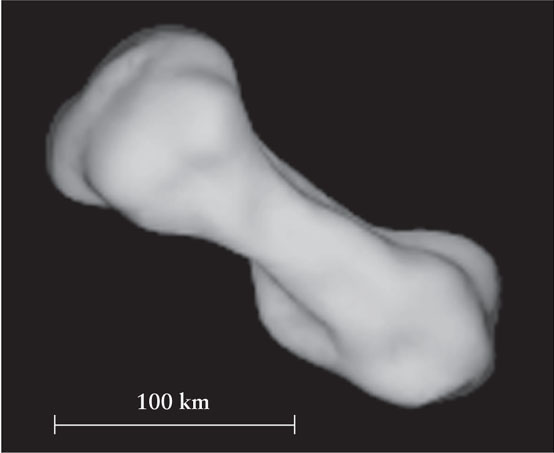
A Radar View of a Medium-Sized Asteroid This radar image reveals the curious dog-bone shape of the asteroid 216 Kleopatra. The 300-m Arecibo radio telescope in Puerto Rico was used both to send radio waves toward Kleopatra and to detect the waves that were reflected back. Scientists then created this image by computer analysis of the reflected waves.
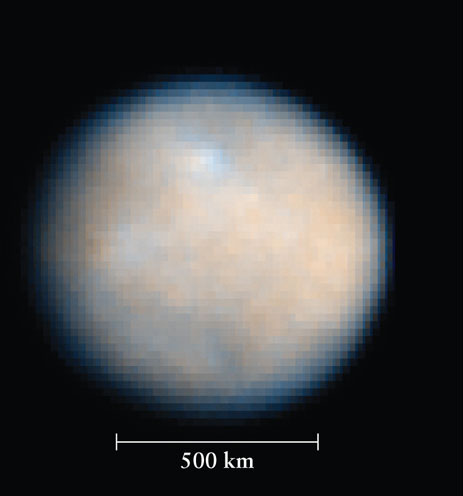
A Hubble Space Telescope View of a Large Asteroid With an equatorial diameter of 974.6 km (605.6 mi), Ceres is the largest of all the asteroids. Its very nearly spherical shape suggests that it was once molten throughout its volume, in which case it probably underwent chemical differentiation like the terrestrial planets (see Box 7-1 and Section 8-5).
An important recent innovation in studying asteroids has been the use of radar. An intense radio beam is sent toward an asteroid, and the reflected signal is detected and analyzed to determine the asteroid’s shape (Figure 15-6). The amount of the radio signal that is reflected also gives clues about the texture of the surface.
 The most powerful technique for studying asteroids is to send a spacecraft to make observations at close range. The Jupiter-bound Galileo spacecraft gave us our first close-up view of an asteroid in 1991, when it flew past 951 Gaspra. Two years later Galileo made a close pass by 243 Ida. The NEAR Shoemaker spacecraft made a close approach to 253 Mathilde in 1997 (Figure 15-7). It later went into orbit around 433 Eros (see Figure 7-7) and touched down on Eros in 2001. It was the first spacecraft to orbit and land on an asteroid. A number of other spacecraft have since made close flybys of asteroids.
The most powerful technique for studying asteroids is to send a spacecraft to make observations at close range. The Jupiter-bound Galileo spacecraft gave us our first close-up view of an asteroid in 1991, when it flew past 951 Gaspra. Two years later Galileo made a close pass by 243 Ida. The NEAR Shoemaker spacecraft made a close approach to 253 Mathilde in 1997 (Figure 15-7). It later went into orbit around 433 Eros (see Figure 7-7) and touched down on Eros in 2001. It was the first spacecraft to orbit and land on an asteroid. A number of other spacecraft have since made close flybys of asteroids.
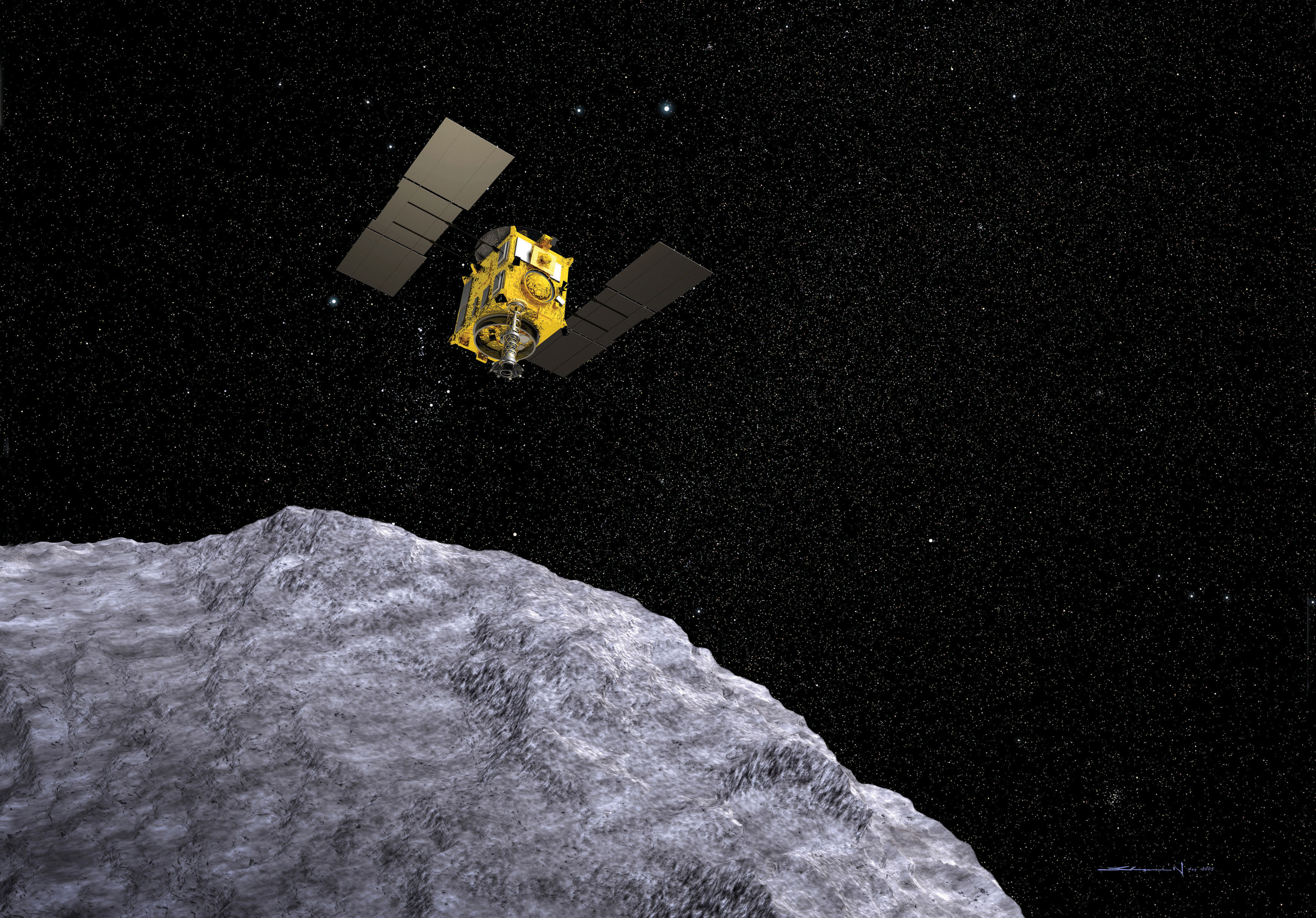
Sample Returned from Itokawa The surface of Itokawa is rough and studded with boulders. It has been described as a “rubble pile.” Compared to Mathilde and other asteroids, Itokawa has a surprising lack of craters. The asteroid may even be the result of two asteroids merging together. The sample returned to Earth contained about 1500 small grains, and is certain to shed light on Itokawa and asteroids in general.
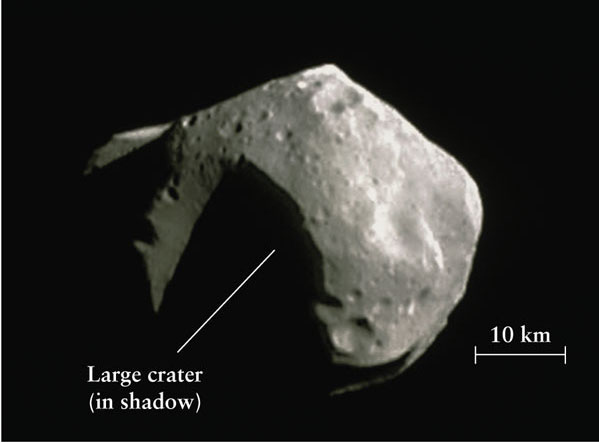
A Spacecraft View of a Small Asteroid The asteroid 253 Mathilde has an albedo of only 0.04, making it half as reflective as a charcoal briquette. It has an irregular shape, with dimensions 66 × 48 × 46 km. The partially shadowed crater indicated by the label is about 20 km across and 10 km deep. The NEAR Shoemaker spacecraft imaged Mathilde at close range during its close flyby in June 1997.
One of the most ambitious asteroid missions to date is Hayabusa (“Falcon”), a project of the Japan Aerospace Exploration Agency. In 2005 it touched down briefly on the surface of 25143 Itokawa, where it gathered small samples of dust from the asteroid’s surface (Figure 15-8). In 2010 the dust samples were safely returned to Earth, completing the first-ever asteroid sample return. Analysis indicates that the dust is probably fragments of a larger asteroid, and that the dust has been exposed to space for about 8 million years. As expected, the composition of the asteroid dust also matches some of the meteoritic material that makes its way to Earth (more on meteorites in Section 15-5).
Hayabusa also contained a mini-lander (about half a pound and 12 cm wide) designed to hop around in Itokawa’s low gravity. Unfortunately, the mini-lander did not deploy correctly and has floated off into space.
Dawn Visits Vesta
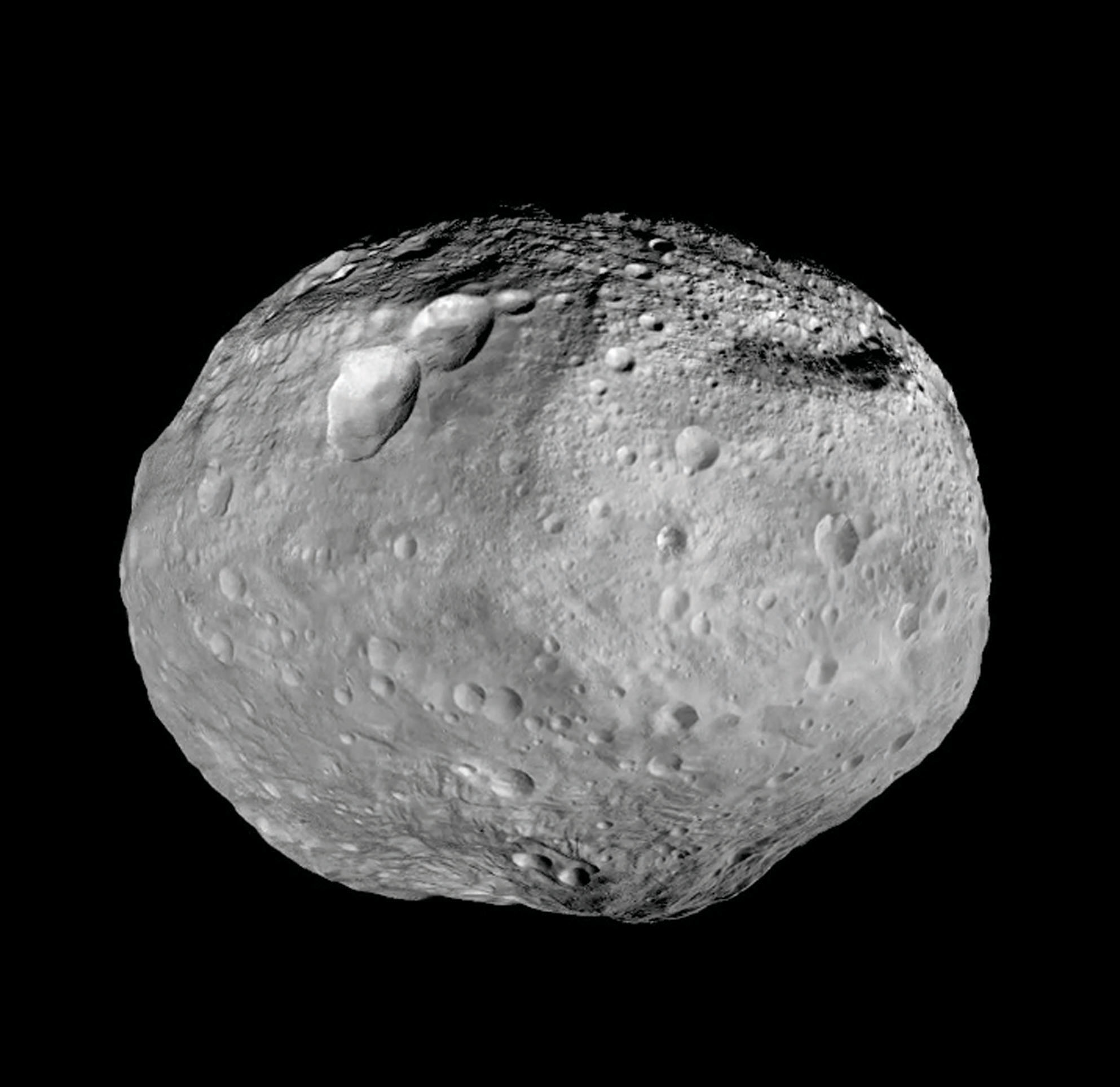
Vesta This view of Vesta is a mosaic composed of the best views from the Dawn spacecraft. Many craters pockmark the surface. Vesta’s average diameter is 525 km.
In 2011, NASA’s Dawn spacecraft went into orbit around Vesta, the second largest asteroid after Ceres (Figure 15-9). Vesta is a remarkable asteroid that some scientists think of as a transitional object between an asteroid and a planet. Vesta has an average diameter of 525 km and is thought to be a remnant protoplanet that never merged with similar objects to build a planet during formation of the solar system. Vesta is not quite massive enough to gravitationally pull itself into a sphere, so it is not a dwarf planet like Ceres. However, Vesta is large enough that its own radioactivity is thought to have melted the asteroid early on, allowing iron to sink to the core (we will learn more about differentiated asteroids in Section 15-5).
Estimates suggest that Vesta lost about 1% of its mass in a huge collision about one or two billion years ago. Amazingly, debris from this impact with Vesta has actually made it to Earth as meteorites. In fact, about 6% of meteorites landing on Earth originated from Vesta. The only other known bodies in the solar system whose rocky debris has been identified on Earth are the Moon and Mars.
The Dawn spacecraft has actually imaged the crater produced by the impact that ejected these rocks from Vesta (Figure 15-10). By analyzing infrared spectra, Dawn has confirmed that the chemical composition around Vesta’s south pole crater matches the meteorites long-suspected to come from this asteroid. The collision at Vesta’s south pole was so energetic that grooves formed around the equator as the entire asteroid vibrated like a ringing bell.
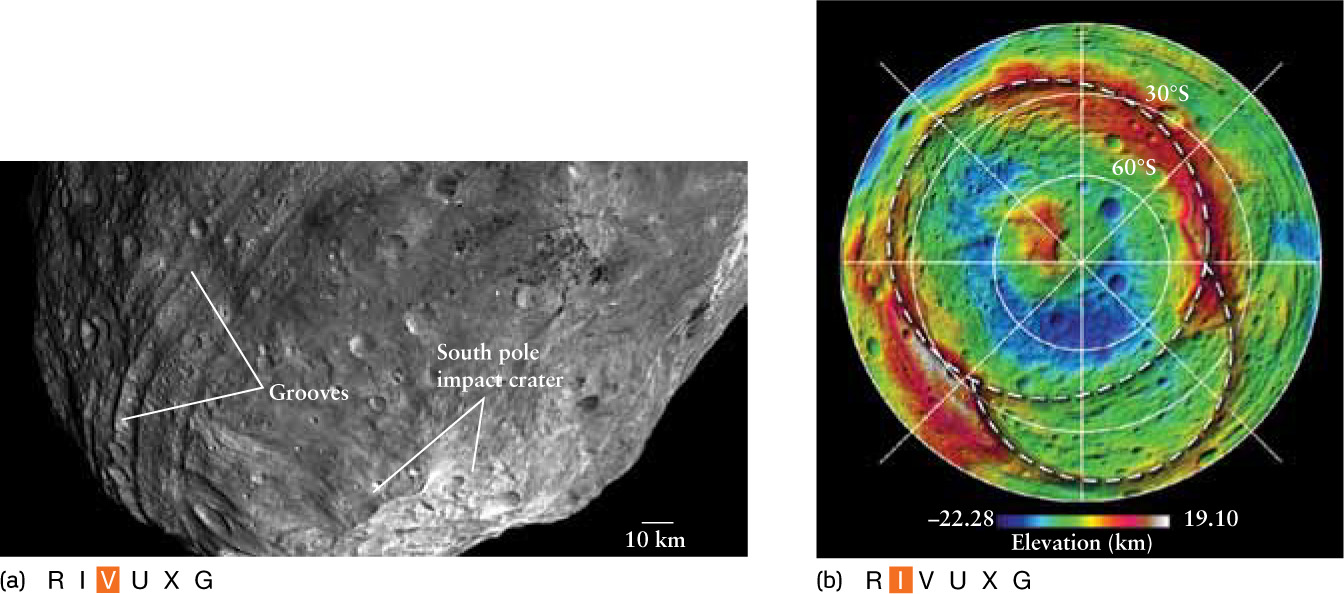
The Dawn mission does not end with Vesta, which it left in September 2012. If all goes according to plan, Dawn will go into orbit around Ceres in 2015.
Collisions and the Nature of Asteroids
What have spacecraft and Earth-based radar told us about the asteroids? To appreciate the answer, we should first consider what scientists expected to find with these tools. Until recently, the consensus among planetary scientists was that the smaller asteroids were solid, rocky objects. The surfaces were presumed to be cratered by impacts, but only relatively small craters were expected. The reason is that an impact forceful enough to make a very large crater would probably fracture a rocky asteroid into two or more smaller asteroids.
The truth proves to be rather different. It is now suspected that most asteroids larger than about a kilometer are not entirely solid, but are actually many smaller solid pieces held together by gravity. An extreme example is Mathilde (see Figure 15-7). This asteroid has such a low density (1300 kg/m3) that it cannot be made of solid rock, which typically has densities of 2500 kg/m3 or higher. Itokawa is also well below the density of solid rock. Therefore, a good description of an asteroid like this is a “rubble pile” of small fragments that fit together loosely. Most likely, billions of years of impacts have totally shattered this asteroid. But the impacts were sufficiently gentle that the resulting fragments drifted away relatively slowly, only to be pulled back onto the asteroid by gravitational attraction.
Another surprising discovery is that some asteroids have extremely large craters, comparable in size to the asteroid itself. In addition to Vesta’s massive south pole crater (Figure 15-10b), an example is the immense crater on Mathilde, shown in Figure 15-7. The object that formed this crater probably collided with Mathilde at a speed of 1 to 5 km/s (2000 to 11,000 mi/h), which could have easily shattered solid rock. Why didn’t this collision break the asteroid completely apart, sending the pieces flying in all directions? The explanation may be that the asteroid had already been broken into a loose collection of fragments before this major impact took place. Such a fragmented asteroid can more easily absorb the energy of a collision than can a solid, rocky one.
ANALOGY
If you fire a rifle bullet at a wine glass, the glass will shatter into tiny pieces. But if you fire the same bullet into a bag full of sand (which has much the same chemical composition as glass), the main damage will be a hole in the bag. In a similar way, an asteroid that is a collection of small pieces can survive a major impact more easily than a solid asteroid.
In some cases a collision that produces a rubble-pile asteroid can eject a piece that goes into orbit around the asteroid. This may explain why a handful of asteroids are known to have satellites. There is even one known case of an asteroid with two satellites, like a miniature planetary system (Figure 15-11). If someone were lucky enough to observe an asteroid soon after an impact, the short-lived debris from head-on collisions could be observed, as in Figure 15-12.
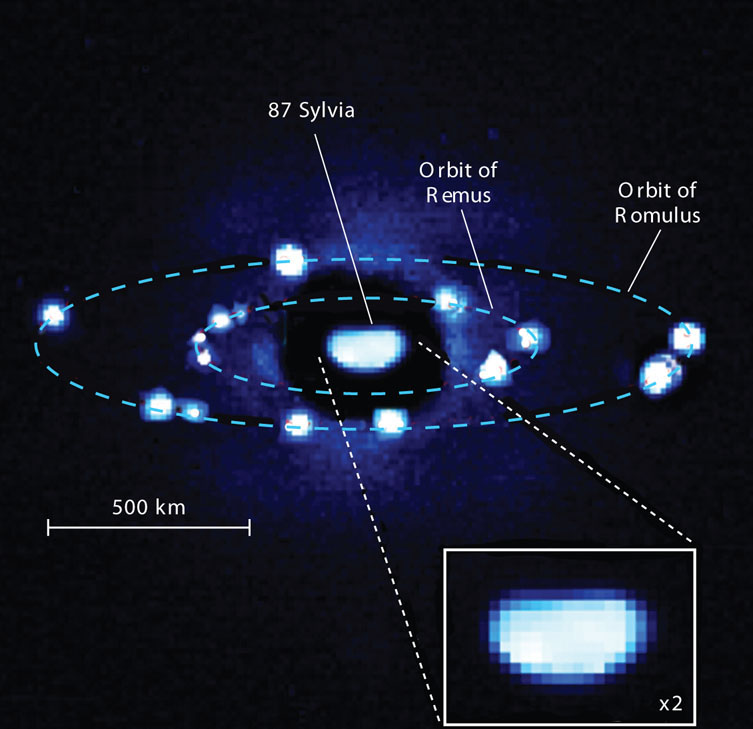
An Asteroid with Two Satellites Although it is only about 280 km across, the potato-shaped asteroid 87 Sylvia has two satellites of its own. The outer satellite, Romulus, is 18 km across; the inner satellite, Remus, is just 7 km across. This image is actually a composite of nine observations made with the adaptive optics system at the Yepun telescope of the European Southern Observatory (see Figure 6-17).

If a collision is sufficiently energetic, it may shatter an asteroid permanently. Evidence for this was first pointed out in 1918 by the Japanese astronomer Kiyotsugu Hirayama. He drew attention to families of asteroids that share nearly identical orbits. Each of these groupings, now called Hirayama families, presumably resulted from a parent asteroid that was broken into fragments by a high-speed, high-energy collision with another asteroid.
CONCEPT CHECK 15-4
How do we know that some meteoritic dust comes from asteroids?
The Hayabusa mission returned samples of the asteroid Itokawa, where analysis on Earth showed a match to meteoritic dust.
CONCEPT CHECK 15-5
Without a returned sample, how did the Dawn spacecraft verify that some meteors on Earth came from the asteroid Vesta?
The Dawn spacecraft was able to assess Vesta’s composition by measuring the infrared spectra of the asteroid’s surface. Analysis finds a match with about 6% of the meteorites found on Earth.